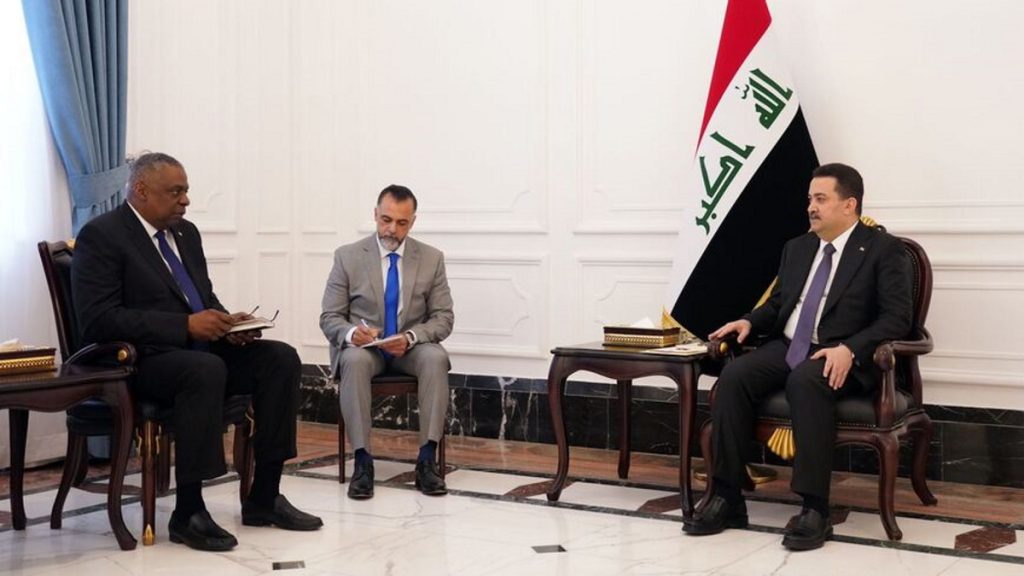According to officials and experts, Lloyd Austin’s visit to Iraq revolves around pushing back Iranian influence in the country.
On March 7, 2023, United States Defense Secretary Lloyd Austin made a sudden visit to the Iraqi capital of Baghdad. At this visit, Austin stressed the US’s commitment to maintaining a military footprint in the Middle Eastern country.
“US forces are ready to remain in Iraq at the invitation of the government of Iraq … The United States will continue to strengthen and broaden our partnership in support of Iraqi security, stability, and sovereignty,” Austin said to reporters after meeting with Iraqi Prime Minister Mohammed Shia al Sudani.
One of the most notable aspects of Austin’s visit was his stop at Erbil in Iraq’s Kurdistan Region. There he held a meeting with the President of the Kurdistan Regional Government (KRG), Nechirivan Barzani. According to a report by The Cradle, Austin not only talked about the importance of the KRG and Iraqi central government working together, he also criticized several airstrikes Iran’s Islamic Revolutionary Guard Corps (IRGC) launched against Kurdish separatist elements towards the end of 2022.
Kurdish separatist movements have built a reputation for carrying out operations along the Iran-Iraq border that are part of broader campaigns to attack Iran. Additionally, this region of Iraq has been rumored to be a launchpad for Israeli intelligence assets.
While Austin’s remarks about his visit to Iraq featured platitudes about promoting defense, national sovereignty, and security, there was an ulterior motive behind this visit.
Several former officials and experts who remained anonymous told outlets such as Reuters that Austin’s visit was focused on resisting Iran’s expanding influence in Iraq.
“I think that Iraqi leaders share your interest in Iraq not becoming a playground for conflict between the United States and Iran,” a senior US defense official said under a condition of anonymity.
Iranian influence in Iraq has become an inevitability due to its proximity to the country and the fact that the US’s two major invasions against Iraq (1991 and 2003) greatly weakened the Iraqi state. The latter developments have allowed Iran to exploit the country’s Shia Muslim majority to establish a foothold in the country’s politics.
Historically speaking, large parts of modern-day Iraq have been under the dominion of the broader Persian civilization state. In many respects, Iran’s growing influence in Iraq represents a reversion to the historical mean.
After the US’s failed nation-building experiment in Iraq, the US largely withdrew its troops from the country to focus on great power competition against nuclear powers such as China and Russia. Currently, the US has 2,500 troops stationed in Iraq. That said, Iran’s strengthening relationship with the Eurasian heavyweights such as China and Russia have American authorities worried and has prevented them from fully pulling troops from Iraq.
In particular, Iran’s alleged assistance in the form of drone supplies to Russia in Ukraine has incensed the US. In all likelihood, the US wants to respond to Iran’s growing defense ties with Russia by keeping forces in Iraq to potentially harass the Islamic Republic further down the line.
It also cannot be overstated how powerful the pro-Israel lobby still is in the US. Israel treats Iran as its mortal enemy. Despite some hiccups here and there, US-Israel relations remain strong, which makes their hostility towards Iran of mutual interest.
With all of these factors in mind, the US will likely maintain a respectable troop presence in Iraq to keep Iran in check. American policymakers appear to be unfazed by the prospect of essentially pursuing “triple containment” against China, Iran, and Russia. Such a proposition will invariably lead to imperial overstretch much to the detriment of the US’s real geopolitical priorities, which should be focused on securing its southern border with Mexico and maintaining stability in the Western Hemisphere.
